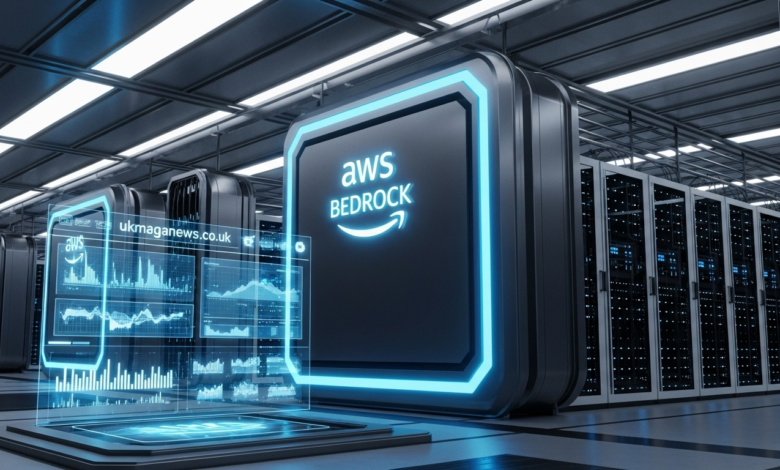AWS Bedrock: Ultimate Guide to Transforming AI Development

Introduction
Imagine having access to the world’s most powerful AI models without worrying about infrastructure, scaling, or maintenance. That’s exactly what AWS Bedrock brings to the table. This fully managed service from Amazon Web Services is changing how businesses and developers approach artificial intelligence.
You’ve probably heard the buzz around generative AI and large language models. Companies everywhere are racing to integrate these technologies into their products. But here’s the challenge: building and maintaining AI infrastructure is incredibly complex and expensive.
AWS Bedrock solves this problem elegantly. It gives you access to foundation models from leading AI companies through a single API. No need to manage servers, worry about scaling, or become an AI infrastructure expert.
In this comprehensive guide, we’ll explore everything you need to know about AWS Bedrock. You’ll learn what it is, how it works, its key features, pricing structure, and practical use cases. Whether you’re a developer, business leader, or AI enthusiast, this article will help you understand why AWS Bedrock matters.
What Is AWS Bedrock?
AWS Bedrock is Amazon’s fully managed service that makes foundation models accessible through an API. Think of it as your gateway to cutting edge AI without the headaches of infrastructure management. You can build and scale generative AI applications using pre-trained models from multiple providers.
The service launched to address a real problem in the AI space. Companies wanted to use advanced AI models but didn’t want to invest millions in infrastructure. They needed something reliable, scalable, and easy to integrate.
Bedrock delivers exactly that. You get access to models from Anthropic, AI21 Labs, Cohere, Meta, Stability AI, and Amazon itself. This variety means you can choose the right model for your specific needs.
What makes AWS Bedrock special is its managed nature. Amazon handles all the heavy lifting. Servers, scaling, updates, and maintenance happen behind the scenes. You simply focus on building amazing AI powered applications.
The platform integrates seamlessly with other AWS services. This means you can combine Bedrock with your existing AWS infrastructure effortlessly. Your data stays secure within your AWS environment.
How AWS Bedrock Works
Understanding how AWS Bedrock operates helps you leverage it effectively. The architecture is surprisingly straightforward despite the complex technology underneath. You interact with foundation models through a simple API interface.
First, you select a foundation model from the available options. Each model has different strengths and capabilities. Some excel at text generation, others at image creation or code generation. Your choice depends on your application requirements.
Next, you send requests to the model through the API. These requests include your prompts and any parameters you want to customize. The model processes your request and returns results almost instantly.
AWS Bedrock handles all the computational heavy lifting automatically. The service scales resources based on demand. During high traffic periods, it allocates more computing power. When things quiet down, it scales back automatically.
Security and privacy are built into every layer. Your data never leaves your AWS environment unless you explicitly configure it to. Models process requests without storing your sensitive information permanently.
You can also fine tune models with your own data. This customization makes models more relevant to your specific use case. The fine tuning process happens securely within your AWS account.
Key Features of AWS Bedrock
AWS Bedrock comes packed with features that make AI development accessible and powerful. Let’s explore what sets this service apart from other AI platforms and why developers love working with it.
Multiple Foundation Models
You’re not locked into a single AI provider. Bedrock offers models from several leading companies. This flexibility means you can experiment and find the perfect fit for your needs.
Anthropic’s Claude models excel at reasoning and following complex instructions. They’re particularly good at maintaining context in long conversations. Many developers prefer Claude for customer service applications.
AI21 Labs provides Jurassic models that handle multilingual tasks beautifully. If you’re building global applications, these models offer excellent language support beyond just English.
Cohere’s models specialize in enterprise applications. They’re optimized for tasks like classification, summarization, and semantic search. Businesses find them reliable for internal tools and workflows.
Meta’s Llama models offer open source flexibility. They perform well across various tasks and give you more control over customization. The community support around Llama is also exceptional.
Serverless Architecture
No server management means faster development and lower operational overhead. AWS Bedrock automatically handles infrastructure provisioning. You never worry about capacity planning or server updates.
Scaling happens automatically based on your usage patterns. When traffic spikes, Bedrock seamlessly adds resources. When demand drops, it scales down to save costs. This elasticity is perfect for unpredictable workloads.
You only pay for what you use. There are no upfront costs or minimum commitments. This pay as you go model makes experimentation affordable. Small projects don’t require massive investments.

Customization and Fine Tuning
While pre-trained models are powerful, customization takes them further. AWS Bedrock lets you fine tune models with your proprietary data. This process creates models that understand your specific domain and terminology.
Fine tuning doesn’t require AI expertise. The platform provides tools that simplify the process. You upload your training data, configure parameters, and Bedrock handles the technical complexity.
The customized models remain private to your account. Your competitors can’t access your fine tuned versions. This privacy protects your competitive advantages and proprietary knowledge.
Enterprise Security
Security features in AWS Bedrock meet enterprise standards. Data encryption happens both in transit and at rest. Your information stays protected at every stage of processing.
AWS Identity and Access Management integration provides granular control. You decide exactly who can access which models and features. This precision helps maintain compliance with internal policies.
Virtual Private Cloud support keeps traffic within your private network. Sensitive workloads never traverse the public internet. This isolation adds another layer of security for regulated industries.
Available AI Models on AWS Bedrock
The variety of models available through AWS Bedrock gives you incredible flexibility. Each model brings unique strengths to different tasks. Understanding these options helps you make informed decisions for your projects.
Anthropic Claude
Claude models represent some of the most advanced AI available today. Claude 3 Opus offers the highest intelligence for complex tasks. It handles nuanced instructions and maintains context exceptionally well.
Claude 3 Sonnet balances performance and cost effectively. It’s fast enough for real time applications while remaining accurate. Many production applications use Sonnet as their primary model.
Claude 3 Haiku provides the fastest response times. It’s perfect for high volume, straightforward tasks. Customer support chatbots often leverage Haiku for quick responses.
These models excel at following instructions precisely. They refuse harmful requests and maintain helpful, honest conversations. Safety and reliability make Claude popular for customer facing applications.
Amazon Titan
Amazon’s own Titan models offer solid performance at competitive prices. Titan Text models handle various text generation and analysis tasks. They integrate particularly well with other AWS services.
Titan Embeddings convert text into numerical representations. These embeddings power semantic search and recommendation systems. The quality rivals specialized embedding services at lower costs.
Titan Image Generator creates images from text descriptions. While not as advanced as some competitors, it handles basic image generation needs. The tight AWS integration makes it convenient for existing AWS users.
Stability AI
Stable Diffusion models on Bedrock enable image generation at scale. You can create, edit, and manipulate images using text prompts. The results often surprise with their quality and creativity.
These models serve various industries from marketing to entertainment. Designers use them for rapid prototyping and concept exploration. Content creators generate unique visuals for blogs and social media.
Commercial licensing comes included with AWS Bedrock access. You can use generated images in commercial projects without additional fees. This clarity simplifies legal considerations for businesses.
Meta Llama
Llama 2 models bring open source flexibility to Bedrock. They perform competitively across many tasks while offering transparency. The research community actively improves Llama, benefiting all users.
Different size variants let you balance performance and cost. Larger models offer better quality but cost more per request. Smaller versions provide adequate performance for simpler tasks.
Use Cases for AWS Bedrock
Real world applications demonstrate AWS Bedrock’s versatility and power. Companies across industries are finding creative ways to leverage foundation models. These examples might spark ideas for your own projects.
Customer Service Automation
Conversational AI transforms customer support operations. AWS Bedrock powers chatbots that understand context and provide helpful responses. These bots handle common questions, freeing human agents for complex issues.
You can integrate Bedrock with existing ticketing systems easily. The API based approach means minimal disruption to current workflows. Implementation often takes weeks instead of months.
Multilingual support becomes feasible even for small teams. Models translate and respond in dozens of languages automatically. This capability opens global markets without hiring multilingual staff.
Content Creation and Marketing
Marketing teams use Bedrock to generate content at scale. Blog posts, social media updates, and product descriptions flow faster. The AI handles first drafts, which humans then refine and personalize.
Personalization reaches new levels with AI assistance. You can generate unique variations of content for different audience segments. This customization improves engagement without multiplying workload.
SEO optimization becomes more data driven. Models analyze search trends and suggest content improvements. They help identify gaps in your content strategy worth addressing.
Code Generation and Development
Developers leverage AWS Bedrock to accelerate software development. The models generate boilerplate code, write tests, and explain complex codebases. This assistance speeds up routine tasks significantly.
Code review gets AI augmentation through Bedrock integration. Models identify potential bugs, security issues, and optimization opportunities. They serve as an additional set of experienced eyes on every commit.
Documentation writing becomes less tedious with AI help. Models generate initial documentation from code comments and function signatures. Developers spend less time writing and more time building.
Data Analysis and Insights
Business intelligence tools integrate AWS Bedrock for natural language queries. Users ask questions in plain English instead of writing SQL. The AI translates questions into queries and explains results.
Report generation happens automatically on schedules you define. Models analyze data, identify trends, and write narrative summaries. Executives get insights without waiting for analyst availability.
Anomaly detection improves with AI pattern recognition. Models learn normal data patterns and flag unusual activity. This early warning system helps prevent problems before they escalate.
Document Processing
Legal and financial firms process documents faster using Bedrock. Models extract key information from contracts, invoices, and reports. What once took hours now completes in minutes.
Summarization helps professionals handle information overload. Long documents become concise summaries highlighting key points. You spend less time reading and more time deciding.
Classification and routing happen automatically based on content. Incoming documents go to appropriate departments without manual sorting. Workflow efficiency improves across entire organizations.
AWS Bedrock Pricing Structure
Understanding costs helps you budget effectively and optimize spending. AWS Bedrock uses a straightforward pay per use model. You’re charged based on input and output tokens processed.
Token Based Pricing
Models charge separately for input tokens and output tokens. Input tokens are the words you send in prompts. Output tokens are the words the model generates in responses.
Different models have different per token rates. More capable models typically cost more per token. You balance capability against budget for each use case.
One token roughly equals four characters in English text. A typical sentence contains about 15 to 20 tokens. These estimates help you predict costs for specific applications.
Fine Tuning Costs
Custom model training incurs additional charges beyond inference. You pay for the compute resources during the training process. The costs depend on model size and training data volume.
Storing custom models also has associated costs. AWS charges monthly for the storage space your models occupy. These fees are typically modest compared to training and inference costs.
Cost Optimization Strategies
Choosing the right model for each task optimizes spending. Don’t use the most expensive model when a simpler one suffices. Match capability to requirement for best value.
Caching frequent prompts reduces redundant processing costs. If you ask similar questions repeatedly, cache the responses. This strategy works well for FAQ systems and common queries.
Batching requests when possible improves efficiency. Processing multiple items together often costs less than individual requests. Your application design influences potential savings here.
Monitoring usage patterns reveals optimization opportunities. AWS provides detailed billing breakdowns by model and application. Regular reviews help identify unexpected cost drivers.
Getting Started with AWS Bedrock
Beginning your AWS Bedrock journey is straightforward. The service integrates smoothly with existing AWS infrastructure. You can start experimenting within minutes of account setup.
Prerequisites and Setup
You need an active AWS account with appropriate permissions. IAM roles control access to Bedrock resources. Your AWS administrator can grant necessary permissions quickly.
Model access requires explicit enablement in your account. AWS Bedrock settings let you request access to specific models. Approval usually happens within minutes for standard models.
Understanding basic API concepts helps but isn’t mandatory. AWS provides comprehensive documentation and examples. The learning curve is gentler than you might expect.
Making Your First API Call
The AWS SDK supports multiple programming languages. Python, JavaScript, Java, and others all work seamlessly. Choose whichever language fits your existing tech stack.
Authentication uses standard AWS credentials and signatures. If you’ve worked with other AWS services, the process feels familiar. Security best practices apply consistently across services.
A simple text generation request requires just a few lines of code. You specify the model, provide a prompt, and receive a response. Results come back as JSON for easy parsing.
Error handling follows AWS conventions and standards. The API returns clear error messages when issues occur. Debugging is straightforward with detailed error information.
Best Practices for Implementation
Start with simple use cases before tackling complex projects. Success with smaller projects builds confidence and understanding. You learn the platform’s quirks without high stakes pressure.
Testing different models reveals which works best for your needs. Performance varies by task and dataset characteristics. Empirical testing beats assumptions every time.
Implementing rate limiting protects against unexpected cost spikes. Set reasonable limits while learning usage patterns. You can always increase limits as confidence grows.
Version control for prompts helps track what works. Treating prompts like code enables systematic improvement. You build a library of effective prompts over time.
AWS Bedrock vs Competitors
The AI platform market offers several alternatives to AWS Bedrock. Understanding differences helps you choose the right solution. Each platform has strengths suited to different needs.
AWS Bedrock vs Azure OpenAI Service
Microsoft Azure offers OpenAI models through their cloud platform. The model selection differs, with Azure focusing heavily on OpenAI’s GPT family. AWS Bedrock provides broader model diversity.
Integration with existing infrastructure influences the choice. If you’re already heavily invested in Azure, their service integrates more naturally. The same logic applies to AWS users considering Bedrock.
Pricing structures differ in subtle but meaningful ways. Both use consumption based pricing, but rate calculations vary. Detailed cost modeling helps predict actual spending accurately.
AWS Bedrock vs Google Cloud Vertex AI
Google’s Vertex AI offers both pre-trained models and custom model training. The platform excels at integrating with Google’s data analytics tools. Bedrock focuses more purely on foundation model access.
Model selection represents another key difference. Vertex AI includes Google’s PaLM and Gemini models. Bedrock offers Anthropic, Meta, and others not available on Google Cloud.
Developer experience varies based on preferred tools. Google Cloud users find Vertex AI more familiar. AWS developers feel more at home with Bedrock’s conventions.
AWS Bedrock vs Direct API Access
You could theoretically call model providers directly without AWS Bedrock. Anthropic, OpenAI, and others offer direct API access. So why use Bedrock as an intermediary?
Unified billing simplifies accounting and budget tracking. You get one bill from AWS covering all models. This consolidation reduces administrative overhead significantly.
Single API interface reduces integration complexity. You write code once and swap models by changing parameters. Direct access requires learning each provider’s unique API.
AWS service integration provides additional value. Connecting Bedrock to Lambda, S3, or DynamoDB happens seamlessly. These integrations would require custom code with direct API access.
Security and Compliance Considerations
Enterprise adoption depends on robust security and compliance features. AWS Bedrock addresses these concerns with comprehensive protections. Understanding security features helps you implement solutions confidently.
Data Privacy and Protection
Your data remains within your AWS account boundary. Models process information without permanently storing it. This architecture protects sensitive business and customer data.
Encryption protects data throughout its lifecycle. Information encrypts in transit using TLS protocols. At rest encryption uses AWS Key Management Service.
Data residency requirements are met through regional deployment. You choose which AWS region hosts your Bedrock workloads. This control helps satisfy geographic data restrictions.
AWS never uses your data to train base models. Your proprietary information stays private and confidential. This guarantee matters enormously for competitive and regulated industries.
Compliance Certifications
AWS Bedrock inherits AWS’s extensive compliance certifications. SOC 2, ISO 27001, and other standards apply. These certifications demonstrate AWS’s commitment to security.
HIPAA eligibility makes healthcare applications possible. Medical providers can build HIPAA compliant applications using Bedrock. Proper implementation requires following AWS guidelines carefully.
GDPR compliance considerations receive attention in Bedrock’s design. Data processing agreements and privacy features support GDPR requirements. European businesses can use Bedrock while meeting regulations.
Access Control and Monitoring
IAM policies provide granular permission management. You control exactly which users and services access Bedrock. Least privilege principles apply easily with detailed permissions.
CloudTrail logging captures all API activity automatically. You can audit who accessed which models and when. This transparency supports security monitoring and compliance reporting.
CloudWatch metrics track usage patterns and performance. Anomaly detection alerts you to unusual activity. These tools help maintain security and optimize operations.

Future of AWS Bedrock
The AI landscape evolves rapidly, and AWS Bedrock evolves with it. Amazon continues investing heavily in artificial intelligence capabilities. Understanding the trajectory helps you plan long term strategies.
Emerging Capabilities
Multimodal models that handle text, images, and audio simultaneously are coming. These models will enable richer, more natural applications. Current separate model limitations will disappear over time.
Longer context windows allow models to process more information at once. Early models handled a few thousand tokens maximum. Newer versions process hundreds of thousands of tokens reliably.
Improved reasoning capabilities make models more reliable for complex tasks. Models are getting better at mathematics, logic, and planning. These improvements expand practical use cases significantly.
Industry Adoption Trends
More industries are experimenting with generative AI applications. What seemed futuristic two years ago is now commonplace. This normalization drives further innovation and investment.
Regulatory frameworks are developing around AI usage. Companies need platforms that adapt to emerging regulations. AWS’s track record with compliance suggests Bedrock will remain compliant.
Skills and training for AI development are spreading. More developers understand how to work with foundation models. This growing expertise accelerates enterprise adoption rates.
Conclusion
AWS Bedrock represents a significant leap forward in making AI accessible. You no longer need deep AI expertise or massive infrastructure to build intelligent applications. The platform democratizes access to cutting edge foundation models through a simple, managed service.
We’ve explored what AWS Bedrock is, how it works, and why it matters. The variety of available models gives you flexibility for different tasks. Enterprise grade security and compliance features make it suitable for serious business applications.
Pricing remains straightforward and consumption based. You pay only for what you use without upfront commitments. This model makes experimentation affordable while scaling economically with success.
Whether you’re building customer service bots, generating marketing content, or analyzing data, AWS Bedrock provides the foundation you need. The platform continues evolving as AI technology advances.
Ready to start building with AWS Bedrock? The best way to learn is by doing. Set up an account, request model access, and start experimenting. What will you create with the power of AI at your fingertips?
Frequently Asked Questions
What is AWS Bedrock used for?
AWS Bedrock is used to build and scale generative AI applications without managing infrastructure. It provides access to foundation models for text generation, image creation, chatbots, content creation, code generation, and data analysis through a single managed API.
How much does AWS Bedrock cost?
AWS Bedrock uses pay per use pricing based on input and output tokens processed. Costs vary by model, ranging from fractions of a cent to several cents per thousand tokens. There are no upfront fees or minimum commitments, making it affordable for experimentation.
What models are available on AWS Bedrock?
AWS Bedrock offers models from Anthropic Claude, Amazon Titan, Meta Llama, Cohere, AI21 Labs Jurassic, and Stability AI. Each provider offers different model sizes and capabilities, giving you flexibility to choose the right model for specific tasks.
Is AWS Bedrock secure for enterprise use?
Yes, AWS Bedrock includes enterprise grade security features. It offers data encryption in transit and at rest, AWS IAM integration, VPC support, and compliance with standards like SOC 2, ISO 27001, and HIPAA. Your data stays within your AWS environment.
Can I fine tune models on AWS Bedrock?
Yes, AWS Bedrock supports fine tuning select models with your proprietary data. This customization improves model performance for your specific use case while keeping your customized model private to your AWS account.
How does AWS Bedrock compare to using OpenAI directly?
AWS Bedrock provides access to multiple model providers through one interface, while OpenAI offers only their models. Bedrock integrates seamlessly with AWS services, provides unified billing, and includes enterprise features like VPC support and detailed IAM controls.
Do I need AI expertise to use AWS Bedrock?
No, AWS Bedrock is designed for developers without deep AI expertise. The managed service handles infrastructure complexity, and the API is straightforward to use. Basic programming knowledge and familiarity with REST APIs are sufficient to get started.
What regions is AWS Bedrock available in?
AWS Bedrock is available in multiple AWS regions including US East, US West, Europe, and Asia Pacific. Availability of specific models may vary by region. Check the AWS Bedrock documentation for current region availability.
Can AWS Bedrock handle high volume production workloads?
Yes, AWS Bedrock automatically scales to handle varying workload demands. The serverless architecture scales up during traffic spikes and down during quiet periods, making it suitable for both small projects and high volume production applications.
How do I get started with AWS Bedrock?
To start with AWS Bedrock, you need an AWS account with appropriate IAM permissions. Enable model access in the Bedrock console, then use the AWS SDK in your preferred programming language to make API calls. AWS provides documentation and code examples to help you begin.Retry
Also Read Ukmaganews.co.uk




